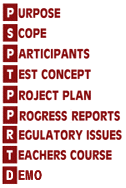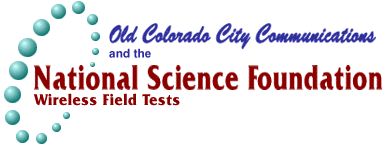
 |































|
CONCEPT FOR EXAMINATION
OF USE OF WIRELESS TECHNOLOGIES
FOR EDUCATION
This project will systematically field test the technical
characteristics of a selected variety of wireless devices and
digital radio nets which can be integrated into telecommunications
data networks, including the Internet, and which can serve the
broadest purposes of education and research by linking computers,
sensing devices, control systems, LANS and WANS operated by
individuals, classrooms, schools and colleges for research, learning
and teaching, connectivity, collaboration, conferencing in textual,
sound, and image modes of communications. Data of use by
It will particularly focus on the devices, topologies,
technical connectivity and interoperability for beta test or
commercially available wireless equipment which operates in the
unlicenced FCC allocated Part 15 ISM bands (902-928Mhz,
2400-2483.5Mhz, 5700-5800Mhz), including spread spectrum
technologies, and the associated technical limits imposed by issues
of allowable range and radiated power, urban and rural
electromagnetic, geographical, and building environments,
(interference, scatter, line loss) availability of field power
sources (where retransmission is required), and interoperability of
wireless with wired networks using the ubiquitous general network
protocols such as TCP/IP, local LAN, serial and ethernet
connectivity.
The object of this investigation is to develop, present and
make widely available, comprehensive public data of value to those
of the 100,000 public and private schools and colleges
who must decide, design, and implement, based on comparative
evaluation of the cost-effectiveness of wired and wireless solutions
to solve their Information infrastructure connectivity problems.
Such data does not currently exist for the emerging technologies of
wireless. It will be conducted as a field test in which the wireless
links will be incorporated into existing, or extend, wired networks,
and Internet services, in order to develop realistic data under
operating conditions.
It will develop data on effective data throughputs,
technical robustness under field conditions through annual weather
cycles, and practical utility 'at the limits' of range, data types
(text, image, sound, video) in circumstances and in places where
costs or conditions for use of wired (telephone or cable networks or
extentions) are cost prohibitive, or impracticable.
The investigation will be conducted among and between
rural and urban schools and the nearest commercial Internet
providers in Colorado. Where wireless, as contrasted with wired,
solutions appear to have the greatest value. The tests will
encompass:
- rural areas where telephone or cable circuitry at
acceptable data rates (56kbs and above) are prohibitive in cost or
unobtainable from rural phone or cable operators.
- within school buildings and local complexes - between
terminating points for outside connectivity (such as 56kb,
fractional, or full T-1 lines) and classrooms, lans, libraries.
- between schools or colleges, including associated
libraries and nearby Internet points-of-presence, or other buildings
in an educational complex are situated, where high data rates (1.54
mb T-1 or above) and bandwidths are needed, but costs of commercial
dedicated lines are too high.
- within typical classroom or study centers - where
multiple computers or workstations are located for simultaneous use,
and wireless lans, or server-workstation connectivity is needed.
- in local areas from outside schools where students
and teachers using home or instituionally supplied computers pursue
research and studies but availability of connectivity is limited by
telephone bandwidths (generally to 28.8k data rates over voice grade
commercial lines)
- in educational and research projects where field data
is gathered outside of schools and laboratories - remote sensing and
continuous data communications.
- in mobile educational (field trip/research) projects.
Commercially available, FCC approved, and prototype
devices under development, from very short range (150 to 1,500 foot,
wireless lan-type), through 1-20 mile range medium speed, to maximum
speed (2mb per second) will be field tested both under:
- routine and sustained educational and research
conditions (normal school year with typical network loads) and
typical educational data transmission.
- special tests of measurable text, sound, image,
video data that test the limits of throughput, robustness, and end
user usability to and from these same institutions.


|
